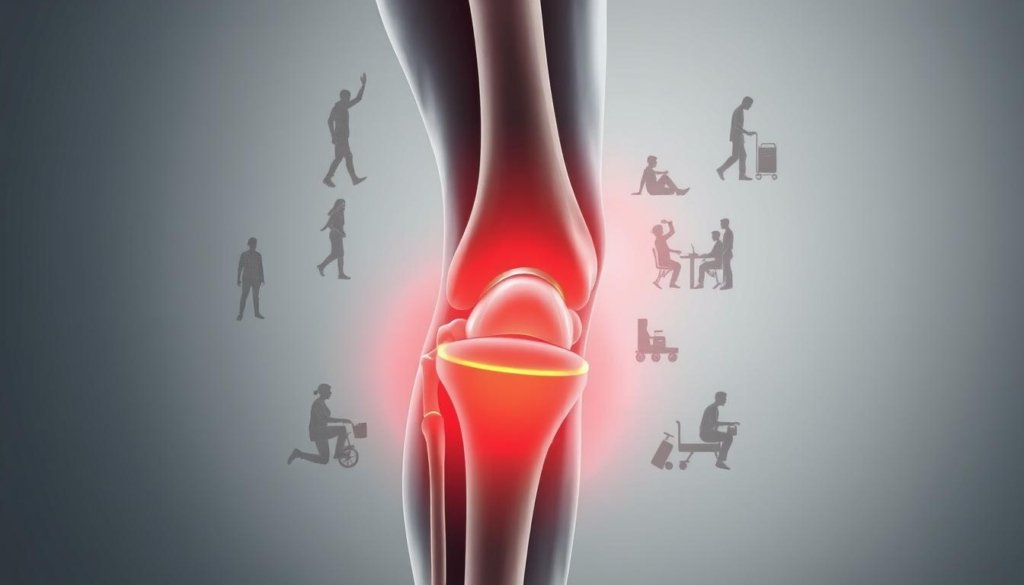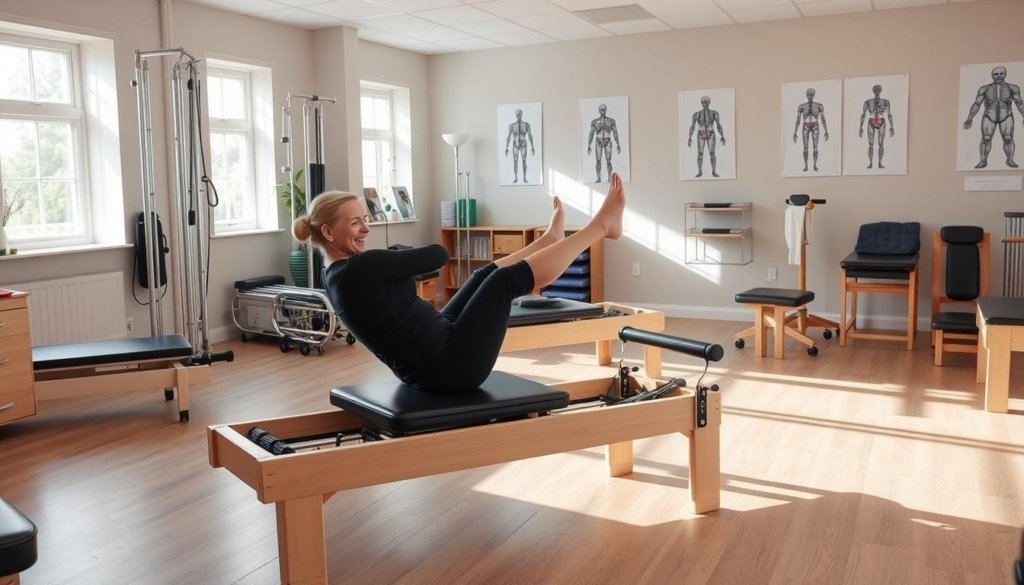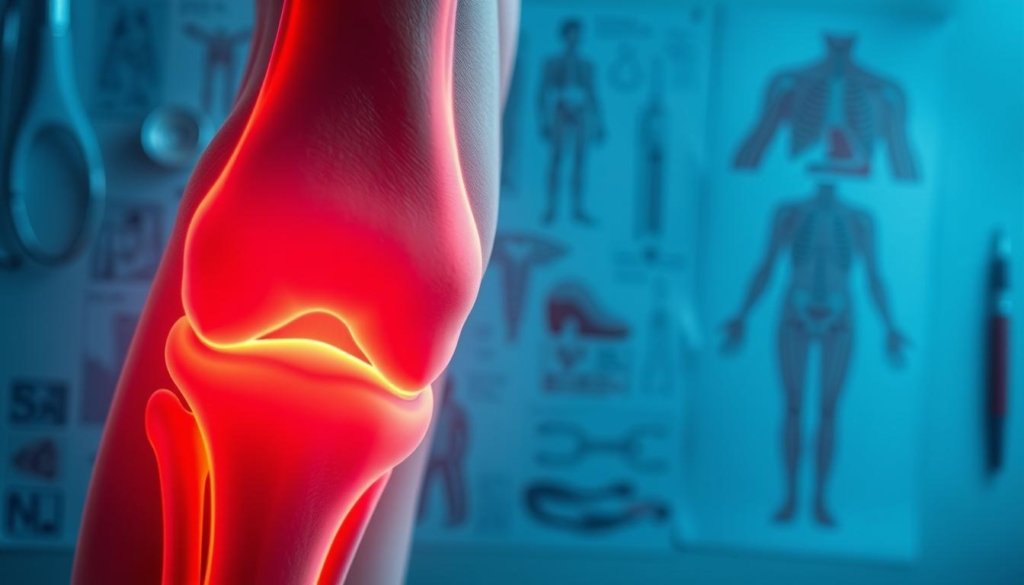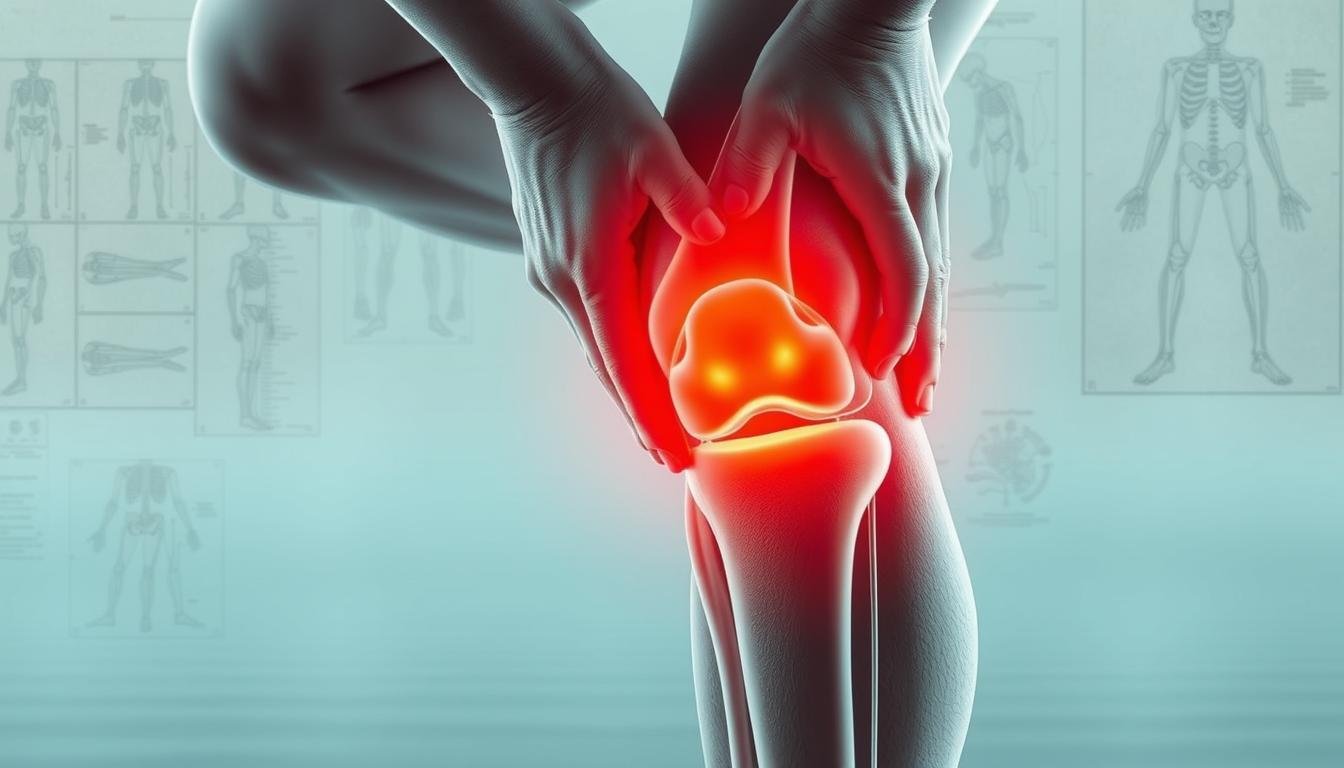Ever had joint pain that keeps you from doing everyday things? It’s normal to feel some aches now and then. But when should you get help from a doctor? As a physiotherapist, I’ve seen how quick action can help manage pain and improve life quality. So, what are the signs you need to see a medical expert?
Key Takeaways
- Recognise when joint pain requires professional assessment and treatment
- Understand the expertise of physiotherapists in managing joint-related issues
- Discover the benefits of early intervention for optimal joint health outcomes
- Learn about the range of evidence-based treatment options available in Australia
- Explore the role of self-management and when it’s time to seek professional help
Understanding Joint Pain and Its Impact on Daily Life
Joint pain can really change how you live, making simple tasks hard. Conditions like arthritis and osteoarthritis can cause pain and limit how you move. This can make everyday life uncomfortable.
Common Types of Joint Pain
Joint pain can affect different parts of the body. Here are some common types:
- Knee pain, often linked to osteoarthritis
- Hip pain, caused by arthritis or other issues
- Shoulder pain, often from rotator cuff injuries or shoulder impingement
- Ankle and foot pain, due to joint inflammation or overuse
Impact on Quality of Life
Joint pain can deeply affect your life. It can make moving around hard, doing daily tasks a struggle, and reduce your activity. This can lead to weight gain, muscle loss, and even mental health issues like depression or anxiety.
Risk Factors and Contributing Factors
Several things can raise your risk of joint pain. These include getting older, past joint injuries, being overweight, family history, and jobs or activities that stress your joints.
| Risk Factor | Description |
|---|---|
| Age | The risk of osteoarthritis and other joint issues grows with age. |
| Joint Injuries | Old injuries, like sprains or fractures, can lead to post-traumatic arthritis. |
| Excess Weight | Being overweight adds stress to joints, especially knees, hips, and ankles, raising the risk of joint inflammation and osteoarthritis. |
| Genetic Factors | Some people are more likely to get certain arthritis, like rheumatoid arthritis, due to their genes. |
| Occupational Factors | Jobs or activities that involve repetitive or heavy work can cause joint pain and related issues. |

“Joint pain can have a profound impact on an individual’s quality of life, making even the most basic daily tasks a challenge.”
Joint pain, Professional help, A Physiotherapist’s Perspective
Managing joint pain is where a physiotherapist’s skills really shine. They offer comprehensive physiotherapy treatment and joint pain assessment. They help patients understand their condition and create treatment plans just for them.
Physiotherapists are full of expert advice. They know a lot about the musculoskeletal system. They can find out why you’re in pain, like from a sports injury or arthritis.
- Comprehensive joint pain assessment
- Personalized physiotherapy treatment plans
- Expertise in addressing the root causes of joint pain
Getting help from a physiotherapist means you get a treatment plan made just for you. They think about your lifestyle and goals. Then, they mix exercises, manual therapy, and special equipment to ease your pain and improve joint function.
“Physiotherapists are essential partners in the management of joint pain, providing invaluable guidance and support throughout the recovery process.”
Physiotherapists work with patients to help them understand their condition. They teach them how to manage their joint pain. This teamwork makes sure the treatment works well and lasts, improving the patient’s life a lot.

Recognising Warning Signs That Require Immediate Attention
Dealing with joint pain can be tough. It’s key to spot signs that mean you need to see a doctor fast. As a physiotherapist, I’ve seen how quick action is vital for joint issues.
Severe Pain and Swelling Indicators
Intense joint pain that stops you from doing daily tasks is a big warning sign. Pain that’s really bad, with swelling or redness, might mean you have an inflammation or injury. You should get medical help right away.
Movement Limitations and Red Flags
Can’t move a joint easily? That’s a red flag too. It could mean you have inflammation or a serious problem. You need a doctor to check it out.
Chronic vs Acute Symptoms
It’s important to tell the difference between long-term and sudden joint pain. Long-term pain might mean you need ongoing care. But sudden pain could be from an injury and needs quick attention.

Spotting these warning signs and getting help can really help with joint pain. Don’t wait to see a physiotherapist or doctor if you’re worried about your symptoms.
The Role of Self-Management in Joint Care
Keeping your joints healthy is key. Self-management can help a lot with joint pain and health. While seeing a doctor is important sometimes, there are many things you can do at home. These can help with mild pain and keep your joints working well.
Effective Home Remedies for Joint Pain Relief
- Use cold or hot packs on the joint to cut down swelling and pain.
- Do gentle stretches and low-impact exercises like swimming or cycling. This helps your joints move better.
- Try natural anti-inflammatory foods like turmeric or ginger to ease pain.
- Keep a healthy weight to lessen the load on your joints and stop them from getting worse.
Lifestyle Modifications for Joint Health
Changing your lifestyle can also help with joint pain and care:
- Eat a diet full of fruits, veggies, and healthy fats to fight inflammation.
- Do regular low-impact activities like walking, yoga, or tai chi. This strengthens and flexes your joints.
- Use stress-reducing methods like meditation or deep breathing to protect your joints from stress.
- Get enough rest and sleep to help your body fix and recover from joint problems.
By using these self-care methods, you can help manage joint pain and keep your joints healthy. This can work alongside any medical treatment you might need.
“Empowering individuals with the knowledge and tools to manage joint pain through self-care can significantly improve their quality of life and long-term joint health.”
When Home Remedies Stop Working: Time to See a Professional
Dealing with persistent joint pain can be tough. Home remedies and over-the-counter treatments help sometimes. But, when they don’t work anymore, it’s time to get help from a professional.
Failed Conservative Treatment Signs
If you’ve tried many treatments like pain meds, ice, heat, and gentle exercises but still hurt, it’s time to see a doctor. Signs that home remedies aren’t working include:
- Increased pain, swelling, or stiffness that doesn’t improve with rest or self-care
- Difficulty performing daily activities or tasks due to your joint pain
- Reduced range of motion or limited mobility in the affected joint
Impact on Work and Daily Activities
Joint pain can really affect your work and daily life. If it stops you from doing your job or enjoying hobbies and social activities, you need professional help.
Progressive Symptoms Assessment
Keep an eye on your joint pain and symptoms over time. If they get worse and your quality of life drops, see a healthcare professional. They can help you figure out what’s wrong and create a plan to get you moving again.
“Don’t wait until your joint pain becomes debilitating. Recognize the signs that it’s time to seek professional help, and take action to improve your long-term joint health.”
Different Healthcare Professionals for Joint Pain Management
Managing joint pain is best done with a multidisciplinary approach. This means working with many healthcare experts. Each one brings their own skills and views to the table. Together, they create a care plan that fits the patient’s needs perfectly.
Physiotherapists are key in managing joint pain. They know a lot about muscles and bones. They help by using exercises, hands-on treatments, and teaching patients how to move better.
Rheumatologists focus on joint problems like arthritis. They work with physiotherapists to give a full care plan. They also prescribe medicines to help with pain and swelling.
Orthopaedic surgeons are experts in surgery for joint issues. They might do joint replacements or repairs. Sometimes, they’re needed when other treatments don’t work.
Healthcare teams work together to tackle joint pain in all its forms. This team effort helps patients take an active role in their recovery. It leads to better health and a happier life.
“A team-based approach to joint pain management ensures that each patient receives personalised care, drawing on the expertise of various specialists to address their unique needs.”
What to Expect During Your First Physiotherapy Session
Going to see a physiotherapist for the first time can feel scary. But knowing what to expect can make you feel better. During your physiotherapy consultation, you’ll get a detailed check-up and a treatment plan made just for you.
Initial Assessment Process
The first step is a detailed joint assessment. Your physiotherapist will look at your medical history and how you’re feeling now. They might check how well you can move and how strong your muscles are. This helps them find out why you’re in pain and how to fix it.
Treatment Plan Development
After the check-up, your physiotherapist will create a personalised treatment plan for you. This might include special exercises, manual therapy, and changes to your lifestyle. They’ll explain each part of the plan so you know why it’s important and how to do it.
Goal Setting and Timeline
- You and your physiotherapist will set goals together, like moving better or feeling less pain.
- You’ll talk about when you want to reach these goals, based on how bad your condition is and your health.
- You’ll have regular meetings to check how you’re doing and make any changes needed.
Your first physiotherapy session is the start of a journey to better joint health. By working together with your physiotherapist, you can manage your pain and do more things you love.
Benefits of Early Intervention in Joint Pain Management
Early action is key when dealing with joint pain. Getting help from a physiotherapist quickly can greatly help. It keeps your joints healthy and mobile for a long time.
One big plus of early treatment is stopping more harm to the joint. Physiotherapists can start preventive care early. This helps avoid serious problems later on.
- Early action leads to better pain management and results.
- Quick physiotherapy helps get your joints moving better and improves your life quality.
- It also helps keep your joints healthy in the long run by fixing the problem early.
Seeing a physiotherapist early also helps you stay active. You can keep doing your daily tasks without pain. This way, you avoid long-term pain and mobility issues.
“Early intervention is key in managing joint pain and ensuring long-term joint health. Physiotherapists play a crucial role in providing comprehensive care and tailored treatment plans to help patients regain their mobility and quality of life.”
In summary, early action in joint pain management is very beneficial. Getting help from a physiotherapist quickly helps prevent more damage. It also improves your treatment results and keeps your joints healthy. This leads to a better life and more mobility without pain.
Evidence-Based Treatment Options Available in Australia
Australians with joint pain can find relief through various treatments. These include advanced physiotherapy and the latest technology. These methods are changing how we manage joint issues, offering better care for everyone.
Modern Physiotherapy Techniques
Physiotherapists in Australia lead in managing joint pain. They use many treatments, like manual therapy and exercises. They also use special modalities to fix the root of the pain.
By using the latest techniques, they give patients solutions that really work. These solutions are made just for each person.
Integration of Technology in Treatment
Technology has made a big difference in joint therapy in Australia. New methods like robotic-assisted rehab and virtual reality programs are being used. These help patients recover faster and get better results.
Australia is a leader in treating joint pain thanks to these efforts. Physiotherapists use these tools to help each patient. This improves their life and lets them do more every day.
“The integration of technology has revolutionized joint therapy in Australia, offering patients more effective and personalized care.”
Conclusion
In this article, we’ve looked at why professional joint care is key. We’ve seen how physiotherapists help manage joint pain. We’ve learned about the different types of joint pain and how they affect our daily lives.
We’ve also talked about the signs that mean you need to see a professional. This helps us understand when it’s time to get expert help.
We’ve discussed the benefits of getting help early and the treatment options in Australia. This knowledge helps us make better choices for our joint health. We’ve seen how professional physiotherapy can improve our lives and help us move better.
When facing joint pain, remember that getting professional joint care from a physiotherapist can change everything. Their skills and custom plans can help you take back control of your joint health. This can lead to a more active and pain-free life.







